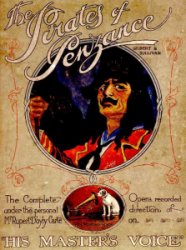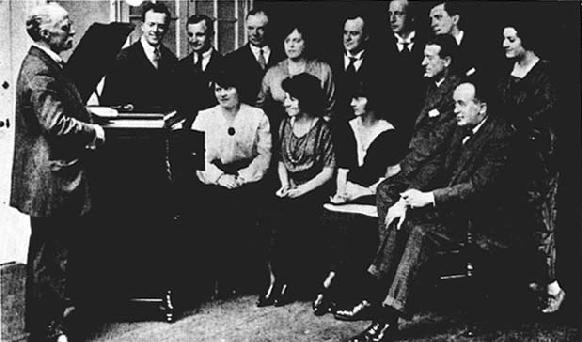The 1920 HMV Pirates
Conductor: George. W. Byng Chorus: Walter Glynne, Ernest Pike, Harold Wilde, Sarah Jones, & The Soloists Recorded in London, July 2 – October 1, 1920 |
|
 HMV Album Cover |
This recording was the fourth in a series of acoustical recordings that began in 1917. The first two sets in the series (Mikado and Gondoliers) had used HMV's own gramophone artists exclusively, but D'Oyly Carte tenor Derek Oldham was included in the 1920 Yeomen, and he appears here as well. The other singers, however, had no association with D'Oyly Carte.
In the early history of the gramophone, little attempt was made to ensure that the same role was played by the same singer throughout an entire set. If a number called for a tenor and a soprano, it seemed that any tenor and any soprano would do. This recording, although it is of comparatively little interest today, was the first in which each singer played only one role, and no role was taken by multiple singers.
Derek Oldham would sing Frederic again on the 1929 Pirates. That recording, and not this one, is the historical Pirates of choice, although this set is certainly a worthwhile document of several important early gramophone singers. It has been re-issued on CD on Chris Webster's Sounds on CD label.
Review from The Gramophone, 1927
 Photograph made at one of the recording sessions. The conductor, George W. Byng, is standing. The singers, reading from left to right, were: Seated: Bessie Jones, Violet Essex, Sarah Jones, Harold WIlde, Robert Radford; Standing: Derek Oldham, Walter Glynne, Ernest Pike, Edna Thornton, Peter Dawson, Edward Halland, George Baker, Nellie Walker. |
| Date | Label | Format | Number |
|---|---|---|---|
| 1921 | HMV | 78rpm | D 504/14 |
| 1999 | Sounds on CD | CD | VGS 211 |
| 2000 | 78s 2 CD | CD | GS07 |
- Substantial excerpts from this recording were included on Pearl GEM 125, a Derek Oldham retrospective disc.
- Side 14 ("When the foeman bares his steel") was included on Arabesque's LP reissue of the 1931 Ruddigore.
The tables below provide details of the sides in continuity order and in the order recorded. The information is derived from the the researches of Michael Walters, Chris Webster, Brian Rust, and John Francis, for which I am most grateful.
| Side Nbr | Matrix Number |
Selection | Rec. Date |
|---|---|---|---|
| 1 | HO4489-2 |
|
13 Jul 20 |
| 2 | HO4488-2 |
|
13 Jul 20 |
| 3 | HO4481 |
|
13 Jul 20 |
| 4 | HO4451-2 |
|
2 Jul 20 |
| 5 | HO4482-2 |
|
13 Jul 20 |
| 6 | HO4450 |
|
2 Jul 20 |
| 7 | HO4486-2 |
|
13 Jul 20 |
| 8 | HO4479 |
|
9 Jul 20 |
| 9 | HO4452 |
|
2 Jul 20 |
| 10 | HO4453 |
|
2 Jul 20 |
| 11 | HO4454-2 |
|
2 Jul 20 |
| 12 | HO4455-2 |
|
2 Jul 20 |
| 13 | HO4456 |
|
2 Jul 20 |
| 14 | HO4474-2 |
|
9 Jul 20 |
| 15 | HO4477 |
|
9 Jul 20 |
| 16 | HO4520-2 |
|
2 Sep 20 |
| 17 | HO4517-2 |
|
31 Aug 20 |
| 18 | HO4548-2 |
|
4 Oct 20 |
| 19 | HO4484-2 |
|
13 Jul 20 |
| 20 | HO4457 |
|
2 Jul 20 |
| 21 | HO4519 |
|
2 Sep 20 |
| 22 | HO4476-2 |
|
9 Jul 20 |
Notes:
- On all records of this period, there was a single extra groove to "guard" the needle from running into the center of the disc. On side 7, in this groove, Violet Essex (or, possibly, another woman) can be heard saying, with some indignation, "I just told him!" On the reverse side of the record, she is apparently saying "I know you did," although it could also be "I know you didn't."
- Francis gives the recording dates of the overture as 14 July 1920. The date of 13 July (from Walters/Rust) seems more likely.
- The record label for side 10 is captioned "I am the very pattern of a modern Major-General" (consistent with early vocal scores), but Baker sings "model".
- Similarly, the record label for side 18 is captioned "Yes, I am brave" (as it was given in early vocal scores), but Violet Essex sings "No, I am brave."
Result | Matrix Number | Selection |
|---|---|---|
| Session One, 2 July 1920 | ||
| Issued s. 6 | HO4450 |
|
| Issued s. 4 | HO4451-2 |
|
| Issued s. 9 | HO4452 |
|
| Issued s. 10 | HO4453 |
|
| Issued s. 11 | HO4454-2 |
|
| Issued s. 12 | HO4455-2 |
|
| Issued s. 13 | HO4456 |
|
| Issued s. 20 | HO4457 |
|
| Session Two, 9 July 1920 | ||
| Issued s. 14 | HO4474-2 |
|
| Rejected | HO4475-1 HO4475-2 |
|
| Issued s. 22 | HO4476-2 |
|
| Issued s. 15 | HO4477 |
|
| Rejected | HO4478-1 HO4478-2 |
|
| Issued s. 8 | HO4479 |
|
| HO4480 | Contents unknown, date unknown | |
| Session Three, 13 July 1920 | ||
| Issued s. 3 | HO4481 |
|
| Issued s. 5 | HO4482-2 |
|
| Rejected | HO4483-1 HO4483-2 |
|
| Issued s. 19 | HO4484-2 |
|
| Rejected | HO4485-1 HO4485-2 |
|
| Issued s. 7 | HO4486-2 |
|
| HO4487 | Contents unknown | |
| Issued s. 2 | HO4488-2 |
|
| Issued s. 1 | HO4489-2 |
|
| Session Four, 31 August 1920 | ||
| HO4516 | See 1920 Yeomen, s. 3 | |
| Issued s. 17 | HO4517-2 |
|
| HO4518 | See 1920 Yeomen, s. 19 | |
| Session Five, 2 September 1920 | ||
| Issued s. 21 | HO4519 |
|
| Issued s. 16 | HO4520-2 |
|
| HO4521 | See 1920 Yeomen, s. 10 | |
| HO4522 | See 1920 Yeomen, s. 12 | |
| Session Six, 4 October 1920 | ||
| Issued s. 18 | HO4548-2 |
|
| HO4549 | See 1920 Yeomen, s. 22 | |
| HO4550 | See 1919 Gondoliers, s. 12 | |
Notes:
- The table above shows the order in which the selections were recorded. The table shows "unknown" takes to highlight gaps in matrix numbers (which were normally assigned sequentially).
- During this period, HMV would record a selection no more than twice on a given day. If this failed to produce a usable take, then the item would be rescheduled for another day. Where this happened, the first attempt is labeled "Rejected" in the table.
- Where the matrix number of an issued side is suffixed "-2", it means that the first take was rejected, but the second was accepted. Where a matrix number has no suffix, it means that the first take was accepted.

